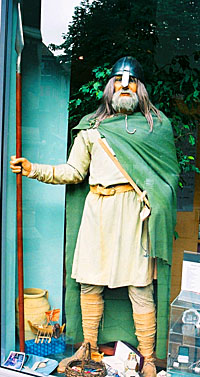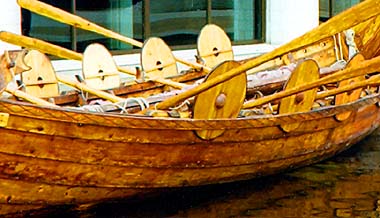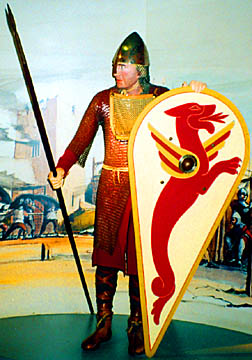
Mannequin representing a Viking spearman
(displayed at the Jorvik Viking Centre, York)
Photo © S. Alsford
Viking and Anglo-Saxon warriors were very similarly equipped, although in each case the more professional of them would have invested in better arms and armour. The greater the amount of worked iron in a weapon or an item of armour, the more expensive it would have been. In the tenth and eleventh centuries, when relatively peaceful conditions encouraged a growth in trade and agriculture, and prosperity spread, it appears that larger numbers of men were able to afford some of the more expensive items.
It is hard to say quite where residents of burhs or wiks fitted into this picture. But we should keep in mind that domestic items used for non-military purposes, such as tools for cutting wood, slaughtering livestock, or hunting could have served many of those called to defend their burhs. On the field of battle, underequipped soldiers may have been used in auxiliary roles.
Spears, comprising an iron head riveted to a wooden shaft, were by far the most common weapon, for soldiers from all ranks in society. There were a number of reasons for this. Incorporating relatively little iron, they were more affordable than swords. They were an effective all-purpose weapon, not least for those soldiers with less training or fighting skills, useful for keeping at a distance an opponent swinging sword or axe; while offensively, the spear could be used single-handed stabbing downwards from an over-arm position (using the other hand to protect oneself with shield), or double-handed for a thrust with enough momentum to penetrate mail armour. And, in a mass battle a line of troops several soldiers deep, protected by a wall of shields and a hedge of spears, provided an effective obstacle to attackers, particularly horsemen, as the Battle of Hastings showed. As a last resort, a spear could also be thrown, although a soldier might have one or more lighter spears, of a javelin type, for throwing; the normal fighting spear had a broader head, as illustrated above.
Swords were relatively uncommon weapons; archaeologically they are far less in evidence, although this must be partly because many were handed down from one generation to the next. Axes were even less common. Axes and swords were offensive weapons and were probably largely restricted to the professional warriors, such as the huscarls, who could use them to best effect.
In terms of protective equipment, helmets were an important investment, since the upper part of the skull was particularly vulnerable to sword and axe swings; they seem to have become increasingly commonly-owned items between the time of Alfred and the Conquest. Simple domed metal helmets, presumably with some kind of interior padding and means of fastening firmly atop the head, were the norm; sometimes a nose-guard (as above) was incorporated, and far less frequently (due to expense) chain-mail extensions to protect the lower part of the head, neck, and even the upper shoulders. Shields must have been even more common than helmets, being the least dispensable item of defensive equipment, and inexpensive because made of wood, with some leather reinforcement. They were normally round and often decorated in some way. Chain-mail shirts (later known as hauberks), sometimes incorporating a hood, seem to have been the preserve of professional warriors, who learned to fight bearing that heavy load. Lesser soldiers do not seem to have employed any soft body-armour (i.e. padded clothing).

This reconstruction of a Viking long ship
(the Mjøsen Lange) illustrates how shields may have
been transported while under sail, by ranging them along the gunwales,
in a sort of battlemented effect that would have given the crew a
measure of protection from the elements.
Photo © S. Alsford
Neither Vikings nor Anglo-Saxons made heavy use of bow and arrow in pitched battles, although the weapon was used in skirmishes, to pick off individual opponents. Nor did they have cavalry. The Anglo-Saxons used horses only to carry them to wherever the enemy was to be found, although they fought only on foot. The need to possess at least one horse, along with appropriate arms and armour, militated against regular fyrd service by any but the upper classes.

TMannequin representing a Norman
cavalryman (displayed at the Yorkshire Museum).
Photo © S. Alsford
The key difference in 1066 between the trops of the Normans and Anglo-Saxons – or for that matter of the Vikings who were the Norman antecedents – was that the Normans employed both archers and cavalry, and had adapted their battle strategy accordingly.
Cavalry required slightly different equipment from infantry. Already Anglo-Saxon soldiers had been starting to adopt kite-shaped shields (as illustrated above), which provided better protection down the length of the body. Horsemen, more susceptible to strikes at their flanks or those of their mounts,found such shields essential to protect the side whose arm held the horse's reins (usually the left), while with the other arm they used the spear – still the primary weapon – either in the overarm stabbing (or throwing in the case of lighter spears) fashion or couched under the arm as a lance, using the weight and speed of the horse to give force to the spear thrust.
Similarly, the mail shirt, modified to allow operating from horseback and sometimes to extend protection to upper leg and arm, was fairly common – the Bayeux Tapestry shows about 39% of the Norman soldiers depicted with armour; infantry were less likely to have it. Nose-guards seem to have been a standard feature of Norman helmets, which were a little more conical by this date. Norman cavalry, as the elite fighters, were also equipped (as back-up) with swords, but again not the infantry. Axes might be used, but the Bayeux Tapestry suggests they were more common among the Anglo-Saxons in 1066. The bow was mainly, but not exclusively, an infantry weapon; the Norman force at Hastings probably included both archers and crossbowmen, both of whose missiles could pierce chain-mail.
The Norman strategy at Hastings of directing missiles (e.g. arrows, javelins) into the enemy line, with a view to demoralizing, goading, and creating gaps that would enable the cavalry to break through, was initially unsuccessful, in part because the upwards slope of attack took the steam out of cavalry charges; it took a lapse of discipline from some of the Anglo-Saxons to give the opening the Normans' needed. Nonetheless, this was esentially the strategy continued in use throughout the remainder of the Middle Ages, as Norman cavalry evolved into English knights.